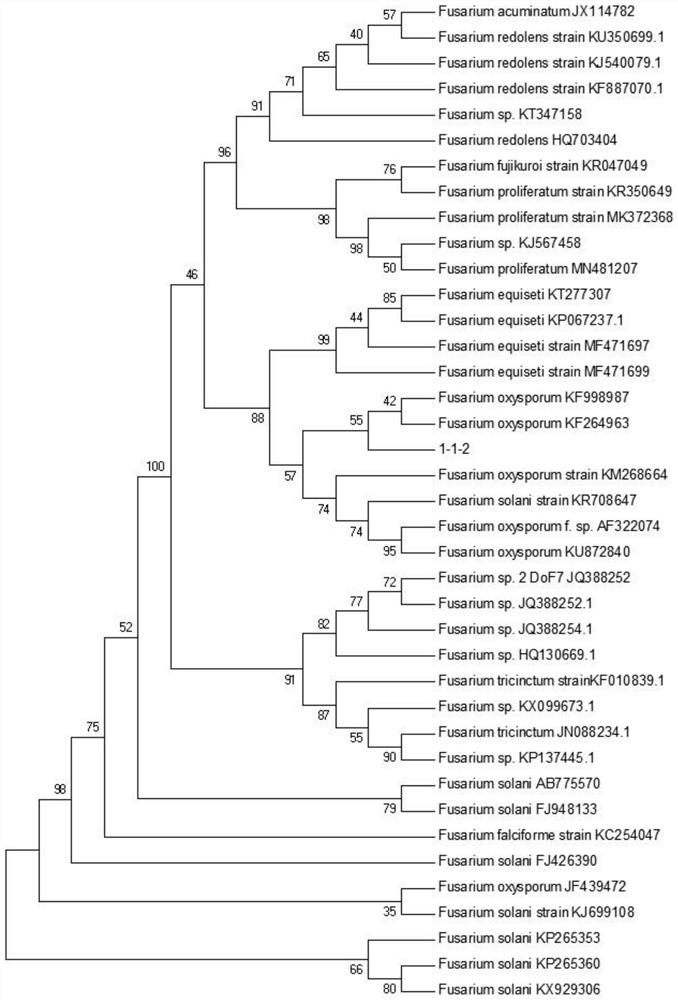Fungus strain for promoting germination of Dendrobium Jinsha River and application thereof
A technology of dendrobium and bacterial strains, applied in the field of plant protection, can solve the problems of low germination rate and hindering the cultivation process of dendrobium seedlings in Jinsha River, etc.
- Summary
- Abstract
- Description
- Claims
- Application Information
AI Technical Summary
Problems solved by technology
Method used
Image
Examples
Embodiment 1
[0041] Induction isolation and purification method of Fusarium strain 1-1-2
[0042] 1) Using the ex situ symbiotic germination technology, the bark in the original environment of Dendrobium Jinshajiang was collected back to the laboratory, ground into powder to make a symbiotic germination matrix, and the mature seeds of Dendrobium Jinshajiang were sown. to form seedlings, such as figure 1 shown;
[0043] 2) After picking the protocorm with good growth, cut it in half, put it on the PDA medium, and cultivate it upside down under the constant temperature condition of 28°C in the dark. When the mycelium grows to a certain length, it is purified. The purification process is to continuously pick the mycelium from the edge of the colony to a new PDA medium for serial transfer. After 3 to 5 times of transfer, pure colonies can be obtained. Morphology and molecular identification of the obtained fungi were carried out, and the most suitable germination-promoting strains were scree...
Embodiment 2
[0047] Identification method of Fusarium 1-1-2 strain
[0048] 1) Morphological classification of strains
[0049] Inoculate the strain on PDA medium and observe the morphological characteristics of the colony, such as figure 2 shown: figure 2 A is the characteristic map of the colony morphology of strain 1-1-2 grown on PDA medium for 4 days, the mycelium is milky white, aerial, the colony morphology is regular and round, and the growth rate is 2.000±0.255cm every two days, The culture time was short, covering a 9cm plate in about 7 days. The initial stage was white short-velvet mycelium, and the color of secondary metabolites was pale yellow in the later stage. figure 2 B is a 1-1-2 conidia diagram. There are two types of conidia. The small conidia is oval to cylindrical with 1 to 3 septa; the large conidia is sickle-shaped or long-cylindrical, scattered Born on aerial mycelium, the number of partitions is mostly 3 to 10 partitions, some have more partitions, and the pa...
Embodiment 3
[0055] The Fusarium sp.1-1-2 strain preserved in Example 2 was inoculated on the PDA medium (200g / L potato, 20g / L glucose, 15g / L agar), cultivated for 7d under the constant temperature condition of 28°C, and grew mycelium , to obtain Fusarium sp.1-1-2 strains.
PUM
 Login to View More
Login to View More Abstract
Description
Claims
Application Information
 Login to View More
Login to View More - R&D
- Intellectual Property
- Life Sciences
- Materials
- Tech Scout
- Unparalleled Data Quality
- Higher Quality Content
- 60% Fewer Hallucinations
Browse by: Latest US Patents, China's latest patents, Technical Efficacy Thesaurus, Application Domain, Technology Topic, Popular Technical Reports.
© 2025 PatSnap. All rights reserved.Legal|Privacy policy|Modern Slavery Act Transparency Statement|Sitemap|About US| Contact US: help@patsnap.com



